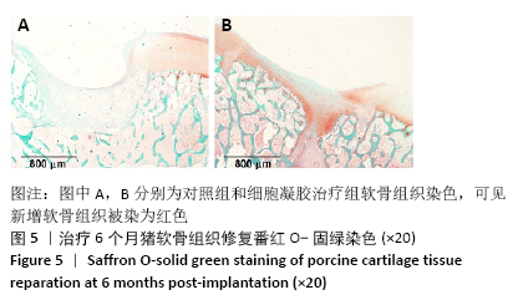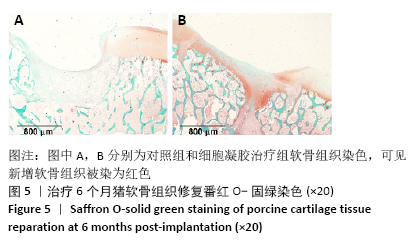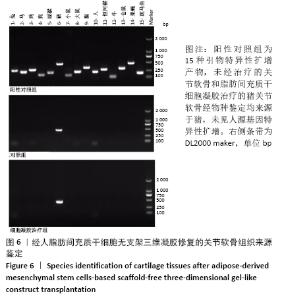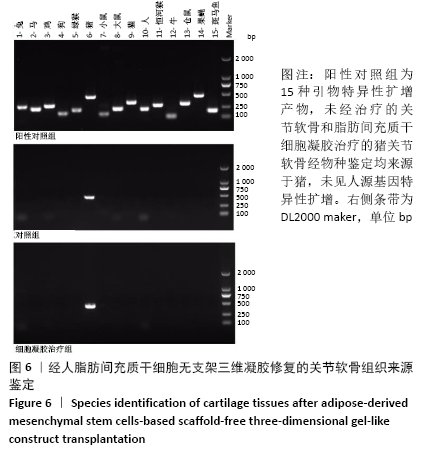Chinese Journal of Tissue Engineering Research ›› 2021, Vol. 25 ›› Issue (19): 2969-2975.doi: 10.3969/j.issn.2095-4344.3526
Previous Articles Next Articles
Knee injury repair using human adipose-derived mesenchymal stem cells-based scaffold-free three-dimensional gel-like construct in pigs
Zhang Jianhui1, Ma Heran1, Tan Yi1, Wang Zhihui1, 2
- 1Qilu Cell Therapy Technology Co., Ltd., Jinan 250000, Shandong Province, China; 2University Creative Research Initiatives Center of Shandong First Medical University, Jinan 250000, Shandong Province, China
-
Received:2020-04-23Revised:2020-04-29Accepted:2020-06-29Online:2021-07-09Published:2021-01-13 -
Contact:Wang Zhihui, PhD, Senior engineering, Qilu Cell Therapy Technology Co., Ltd., Jinan 250000, Shandong, China; University Creative Research Initiatives Center of Shandong First Medical University, Jinan 250000, Shandong Province, China -
About author:Zhang Jianhui, Master, Qilu Cell Therapy Technology Co., Ltd., Jinan 250000, Shandong Province, China -
Supported by:Shandong Taishan Industry Leading Talent Project, No. [2017]199 (to WZH)
CLC Number:
Cite this article
Zhang Jianhui, Ma Heran, Tan Yi, Wang Zhihui. Knee injury repair using human adipose-derived mesenchymal stem cells-based scaffold-free three-dimensional gel-like construct in pigs[J]. Chinese Journal of Tissue Engineering Research, 2021, 25(19): 2969-2975.
share this article

2.1 人脂肪间充质干细胞纯度高,能分化为骨、软骨和脂肪 经体外培养,人脂肪间充质干细胞呈长梭状、贴壁生长,见图1A。流式细胞术鉴定细胞表型,结果显示CD29、CD44、CD90、CD105阳性细胞比例分别为(99.2±0.51)%,(98.9±0.69)%,(99.6±0.21)%,(98.3±0.23)%;CD31、CD34、CD45均为阴性,证明细胞纯度较高,图1B为第5代人脂肪间充质干细胞8个批次样本的表型统计分析图。人脂肪间充质干细胞成脂诱导10 d后,显微镜下可见细胞内脂肪滴成簇状分布,经油红O染色可见脂肪滴被染成红色,见图1C;成骨诱导10 d后,茜素红染色可见大量红色着色区,为钙沉淀,见图1D;成软骨诱导14 d后,软骨球中心部细胞排布致密,阿利新蓝染色呈亮蓝色,外周细胞排布相对松散,着色相对较浅,见图1E。 "


2.2 人脂肪间充质干细胞无支架三维凝胶保持干性和分化能力 人脂肪间充质干细胞高密度铺板于 6 cm培养皿(21 cm2), 经凝胶诱导7-14 d,细胞分泌胶原,细胞之间胶联,只需轻微的剪切力便可将贴壁凝胶从培养皿揭起,在培养基中呈细胞膜片状态,将其从培养基中取出,此组织工程结构呈水样凝胶状态,透明,见图2A。 将获得的人脂肪间充质干细胞无支架三维凝胶分别进行成脂、成骨、成软骨分化诱导,切片进行染色鉴定,结果见图2B。成脂诱导分化后,细胞中的油滴被油红O染成亮红色;成骨诱导后产生的钙沉积被茜素红染成红色;成软骨诱导分化后被阿利新蓝染成亮蓝色。结果说明人脂肪间充质干细胞凝胶仍具有分化能力,保持干性。"

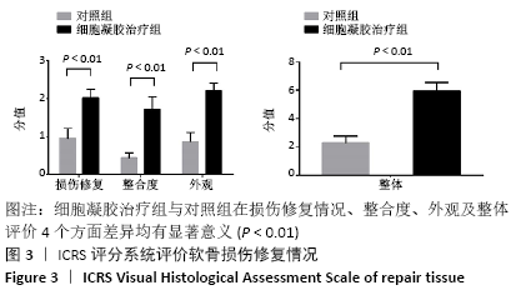
2.3 人脂肪间充质干细胞无支架三维凝胶能促进猪膝关节软骨修复 在10只模型猪两膝造模,右膝进行凝胶治疗,左膝为对照侧,不进行治疗。在治疗过程中发现,人脂肪间充质干细胞无支架三维凝胶能够粘合在猪软骨缺损部位,并且不需要额外修剪即可充满损伤部位。9只实验猪在手术后1-5 d出现双侧膝关节肿胀,6-12 d轻微肿胀,13 d以后恢复正常。1只猪膝关节有感染,经抗生素治疗后恢复正常。9只猪在手术后24 h开始尝试站立,48 h正常站立并恢复正常行走。 10只实验猪中,治疗4个月解剖2只,均没有明显修复;6个月解剖5只其中有3只有效;8个月解剖3只有2只有效。经过6-8个月治疗,治疗有效率为62.5%(5/8)。 在治疗后4,6,8个月解剖动物观察软骨修复情况。结果显示,治疗4个月,凝胶填充在软骨损伤部位,但未分化为软骨组织;未经治疗的对照侧有出血点,解剖的2只猪均没有明显的治疗效果。剩余猪继续治疗,6个月解剖5只,8个月解剖3只,未经治疗的对照侧有部分软骨修复,治疗组关节损伤处较对照侧修复更完善,缺损处伤口更浅,有一定的修复效果,修复程度是缺损深度的50%。根据ICRS评分系统评价软骨修复情况,从软骨修复程度、整合度、外观及整体评价4个方面进行评分及统计,结果发现:软骨修复程度(P=0.009,n=8)、整合度(P=0.002,n=8)、外观(P=0.000 5,n=8)及整体修复情况(P=0.000 3,n=8)有显著差异,见图3,说明人脂肪间充质干细胞无支架三维凝胶对软骨损伤有一定的修复作用。 "
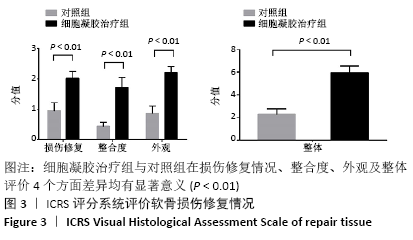
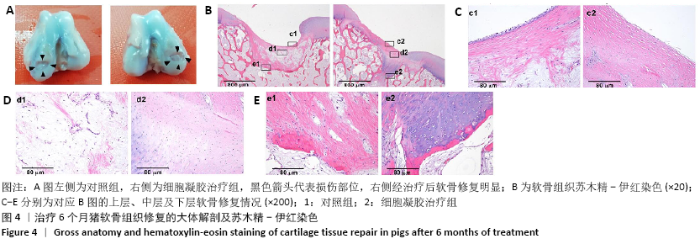
以1只动物为例显示软骨修复情况,见图4,并对修复的软骨组织进行组织病理切片、苏木精-伊红染色。如图可见,表层位置:两组表面都有一层很薄的纤维肉芽组织,平行交错排列胶原纤维束呈嗜酸性,被染成红色,见图4C;中层位 置:细胞凝胶治疗组由纤维肉芽组织逐渐变为透明软骨,从外至内细胞由少变多,由小变大,说明软骨细胞由幼稚转变为成熟,属于外加生长或软骨膜下生长,见图4D。对照组少量纤维束,多为类骨质,其间仍可见残存肉芽组织中的大量血管。最深层位置:对照组含有大量纤维的类骨质,未见软骨囊,未见透明软骨;细胞凝胶治疗组软骨囊呈强嗜碱性,深蓝色软骨囊里面有软骨细胞,这里的软骨细胞分裂增殖属于间质生长,见图4E。番红固绿染色显示新增组织为软骨组织,蛋白聚糖被番红O染为红色,见图5。结果显示,对照组损伤明显,细胞凝胶治疗组损伤底层可见成群分布的成熟软骨细胞,向上逐渐过渡为幼稚的软骨细胞,表浅部位仍可见残存的肉芽组织。 "
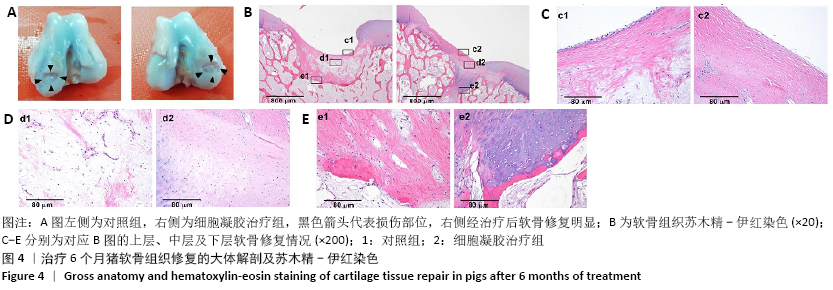
| [1] MARTIN I, MIOT S, BARBERO A, et al. Osteochondral tissue engineering. J Biomech. 2007;40(4):750-765. [2] 薛浩,刘岩,冉博,等.膝关节骨性关节炎治疗现状[J].医学综述, 2018,24(2):321-325,330. [3] THEODOULOU A, KRISHNAN J, AROMATARIS E. Risk of complications in patients who are obese following upper limb arthroplasty: A systematic review and meta-analysis. Obes Res Clin Pract. 2020;14(1):9-26. [4] JO CH, LEE YG, SHIN WH, et al. Intra-articular injection of mesenchymal stem cells for the treatment of osteoarthritis of the knee: a proof-of-concept clinical trial. Stem Cells. 2014;32(5):1254-1266. [5] KIM YS, KOH YG. Injection of Mesenchymal Stem Cells as a Supplementary Strategy of Marrow Stimulation Improves Cartilage Regeneration After Lateral Sliding Calcaneal Osteotomy for Varus Ankle Osteoarthritis: Clinical and Second-Look Arthroscopic Results. Arthroscopy. 2016;32(5):878-889. [6] DING DC, SHYU WC, LIN SZ. Mesenchymal stem cells. Cell Transplant. 2011;20(1):5-14. [7] MAUMUS M, MANFERDINI C, TOUPET K, et al. Adipose mesenchymal stem cells protect chondrocytes from degeneration associated with osteoarthritis. Stem Cell Res. 2013;11(2):834-844. [8] DAMIA E, CHICHARRO D, LOPEZ S, et al. Adipose-Derived Mesenchymal Stem Cells: Are They a Good Therapeutic Strategy for Osteoarthritis? Int J Mol Sci. 2018;19(7):1926. [9] SONG Y, DU H, DAI C, et al. Human adipose-derived mesenchymal stem cells for osteoarthritis: a pilot study with long-term follow-up and repeated injections. Regen Med. 2018;13(3):295-307. [10] ZHOU J, WANG Y, CUI W, et al. Transplantation of adipose derived mesenchymal stem cells alleviated osteoarthritis induced with anterior cruciate ligament transection. Zhonghua Yi Xue Za Zhi. 2016;96(13): 1047-1052. [11] 田霖,孙筱放,刘海波,等.人脂肪干细胞的分离培养与生物学特性[J].中国组织工程研究,2012,16(32):5946-5952. [12] GONZALEZ-REY E, GONZALEZ MA, VARELA N, et al. Human adipose-derived mesenchymal stem cells reduce inflammatory and T cell responses and induce regulatory T cells in vitro in rheumatoid arthritis. Ann Rheum Dis. 2010;69(1):241-248. [13] LOPEZ-SANTALLA M, MANCHEÑO-CORVO P, MENTA R, et al. Human Adipose-Derived Mesenchymal Stem Cells Modulate Experimental Autoimmune Arthritis by Modifying Early Adaptive T Cell Responses. Stem Cells. 2015;33(12):3493-3503. [14] ANDO W, TATEISHI K, HART DA, et al. Cartilage repair using an in vitro generated scaffold-free tissue-engineered construct derived from porcine synovial mesenchymal stem cells. Biomaterials. 2007; 28(36):5462-5470. [15] SHIMOMURA K, ANDO W, TATEISHI K, et al. The influence of skeletal maturity on allogenic synovial mesenchymal stem cell-based repair of cartilage in a large animal model. Biomaterials. 2010;31(31): 8004-8011. [16] LI H, WANG D, YUAN Y, et al. New insights on the MMP-13 regulatory network in the pathogenesis of early osteoarthritis. Arthritis Res Ther. 2017;19(1):248. [17] LI J, ZHU X, SHAO Q, et al. Allogeneic adipose-derived stem cell transplantation on knee osteoarthritis rats and its effect on MMP-13 and DDR2. Exp Ther Med. 2019;18(1):99-104. [18] FREITAG J, BATES D, WICKHAM J, et al. Adipose-derived mesenchymal stem cell therapy in the treatment of knee osteoarthritis: a randomized controlled trial. Regen Med. 2019;14(3):213-230. [19] ZHOU J, WANG Y, LIU Y, et al. Adipose derived mesenchymal stem cells alleviated osteoarthritis and chondrocyte apoptosis through autophagy inducing. J Cell Biochem. 2018 Oct 13. doi: 10.1002/jcb.27530. Online ahead of print. [20] FREITAG J, LI D, WICKHAM J, et al. Effect of autologous adipose-derived mesenchymal stem cell therapy in the treatment of a post-traumatic chondral defect of the knee. BMJ Case Rep. 2017;2017:bcr2017220852. [21] BAHARLOU R, RASHIDI N, AHMADI-VASMEHJANI A, et al. Immunomodulatory Effects of Human Adipose Tissue-derived Mesenchymal Stem Cells on T Cell Subsets in Patients with Rheumatoid Arthritis. Iran J Allergy Asthma Immunol. 2019;18(1):114-119. [22] GONZÁLEZ MA, GONZALEZ-REY E, RICO L, et al. Treatment of experimental arthritis by inducing immune tolerance with human adipose-derived mesenchymal stem cells. Arthritis Rheum. 2009;60(4): 1006-1019. [23] HUNZIKER EB. Articular cartilage repair: basic science and clinical progress. A review of the current status and prospects. Osteoarthritis Cartilage. 2002;10(6):432-463. [24] HUNZIKER EB, ROSENBERG LC. Repair of partial-thickness defects in articular cartilage: cell recruitment from the synovial membrane. J Bone Joint Surg Am. 1996;78(5):721-733. [25] LEE CR, GRODZINSKY AJ, HSU HP, et al. Effects of a cultured autologous chondrocyte-seeded type II collagen scaffold on the healing of a chondral defect in a canine model. J Orthop Res. 2003;21(2):272-281. [26] DOROTKA R, BINDREITER U, MACFELDA K, et al. Marrow stimulation and chondrocyte transplantation using a collagen matrix for cartilage repair. Osteoarthritis Cartilage. 2005;13(8):655-664. [27] NAKAMURA N, HORIBE S, IWAHASHI T, et al. Healing of a chondral fragment of the knee in an adolescent after internal fixation. A case report. J Bone Joint Surg Am. 2004;86(12):2741-2746. [28] ZHANG J, DONG S, SIVAK WN, et al. Stem Cells in Cartilage Diseases and Repair 2018. Stem Cells Int. 2018;2018:3672890. [29] SHIMOMURA K, YASUI Y, KOIZUMI K, et al. First-in-Human Pilot Study of Implantation of a Scaffold-Free Tissue-Engineered Construct Generated From Autologous Synovial Mesenchymal Stem Cells for Repair of Knee Chondral Lesions. Am J Sports Med. 2018;46(10):2384-2393. [30] ISLAM A, HANSEN AK, MENNAN C, et al. Mesenchymal stromal cells from human umbilical cords display poor chondrogenic potential in scaffold-free three dimensional cultures. Eur Cell Mater. 2016;31: 407-424. |
| [1] | Pu Rui, Chen Ziyang, Yuan Lingyan. Characteristics and effects of exosomes from different cell sources in cardioprotection [J]. Chinese Journal of Tissue Engineering Research, 2021, 25(在线): 1-. |
| [2] | Lin Qingfan, Xie Yixin, Chen Wanqing, Ye Zhenzhong, Chen Youfang. Human placenta-derived mesenchymal stem cell conditioned medium can upregulate BeWo cell viability and zonula occludens expression under hypoxia [J]. Chinese Journal of Tissue Engineering Research, 2021, 25(在线): 4970-4975. |
| [3] | Huang Dengcheng, Wang Zhike, Cao Xuewei. Comparison of the short-term efficacy of extracorporeal shock wave therapy for middle-aged and elderly knee osteoarthritis: a meta-analysis [J]. Chinese Journal of Tissue Engineering Research, 2021, 25(9): 1471-1476. |
| [4] | Li Dadi, Zhu Liang, Zheng Li, Zhao Fengchao. Correlation of total knee arthroplasty efficacy with satisfaction and personality characteristics [J]. Chinese Journal of Tissue Engineering Research, 2021, 25(9): 1346-1350. |
| [5] | Wei Wei, Li Jian, Huang Linhai, Lan Mindong, Lu Xianwei, Huang Shaodong. Factors affecting fall fear in the first movement of elderly patients after total knee or hip arthroplasty [J]. Chinese Journal of Tissue Engineering Research, 2021, 25(9): 1351-1355. |
| [6] | Wang Jinjun, Deng Zengfa, Liu Kang, He Zhiyong, Yu Xinping, Liang Jianji, Li Chen, Guo Zhouyang. Hemostatic effect and safety of intravenous drip of tranexamic acid combined with topical application of cocktail containing tranexamic acid in total knee arthroplasty [J]. Chinese Journal of Tissue Engineering Research, 2021, 25(9): 1356-1361. |
| [7] | Xiao Guoqing, Liu Xuanze, Yan Yuhao, Zhong Xihong. Influencing factors of knee flexion limitation after total knee arthroplasty with posterior stabilized prostheses [J]. Chinese Journal of Tissue Engineering Research, 2021, 25(9): 1362-1367. |
| [8] | Huang Zexiao, Yang Mei, Lin Shiwei, He Heyu. Correlation between the level of serum n-3 polyunsaturated fatty acids and quadriceps weakness in the early stage after total knee arthroplasty [J]. Chinese Journal of Tissue Engineering Research, 2021, 25(9): 1375-1380. |
| [9] | Zhang Xiumei, Zhai Yunkai, Zhao Jie, Zhao Meng. Research hotspots of organoid models in recent 10 years: a search in domestic and foreign databases [J]. Chinese Journal of Tissue Engineering Research, 2021, 25(8): 1249-1255. |
| [10] | Wang Zhengdong, Huang Na, Chen Jingxian, Zheng Zuobing, Hu Xinyu, Li Mei, Su Xiao, Su Xuesen, Yan Nan. Inhibitory effects of sodium butyrate on microglial activation and expression of inflammatory factors induced by fluorosis [J]. Chinese Journal of Tissue Engineering Research, 2021, 25(7): 1075-1080. |
| [11] | Wang Xianyao, Guan Yalin, Liu Zhongshan. Strategies for improving the therapeutic efficacy of mesenchymal stem cells in the treatment of nonhealing wounds [J]. Chinese Journal of Tissue Engineering Research, 2021, 25(7): 1081-1087. |
| [12] | Liao Chengcheng, An Jiaxing, Tan Zhangxue, Wang Qian, Liu Jianguo. Therapeutic target and application prospects of oral squamous cell carcinoma stem cells [J]. Chinese Journal of Tissue Engineering Research, 2021, 25(7): 1096-1103. |
| [13] | Xie Wenjia, Xia Tianjiao, Zhou Qingyun, Liu Yujia, Gu Xiaoping. Role of microglia-mediated neuronal injury in neurodegenerative diseases [J]. Chinese Journal of Tissue Engineering Research, 2021, 25(7): 1109-1115. |
| [14] | Li Shanshan, Guo Xiaoxiao, You Ran, Yang Xiufen, Zhao Lu, Chen Xi, Wang Yanling. Photoreceptor cell replacement therapy for retinal degeneration diseases [J]. Chinese Journal of Tissue Engineering Research, 2021, 25(7): 1116-1121. |
| [15] | Jiao Hui, Zhang Yining, Song Yuqing, Lin Yu, Wang Xiuli. Advances in research and application of breast cancer organoids [J]. Chinese Journal of Tissue Engineering Research, 2021, 25(7): 1122-1128. |
| Viewed | ||||||
|
Full text |
|
|||||
|
Abstract |
|
|||||
